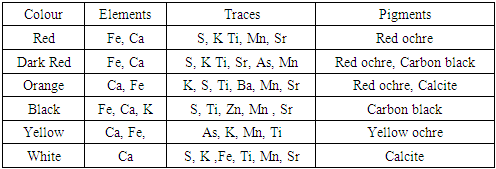-
Paper Information
- Next Paper
- Previous Paper
- Paper Submission
-
Journal Information
- About This Journal
- Editorial Board
- Current Issue
- Archive
- Author Guidelines
- Contact Us
Archaeology
p-ISSN: 2332-838X e-ISSN: 2332-841X
2021; 9(1): 24-27
doi:10.5923/j.archaeology.20210901.05

Analysis of Pigments in Etruscan Tombs in Sorano, Italy Using the pXRF Spectroscopy
Meropi Katsantoni1, Theodore Ganetsos1, Carmela Crescenzi2, Foteini Stringari2
1Department of Industrial Design and Production Engineering, Non-Destructive Techniques Laboratory, University of West Attica, Athens, Greece
2Department of Architecture, University of Florence, Florence, Italy
Correspondence to: Meropi Katsantoni, Department of Industrial Design and Production Engineering, Non-Destructive Techniques Laboratory, University of West Attica, Athens, Greece.
| Email: |  |
Copyright © 2021 The Author(s). Published by Scientific & Academic Publishing.
This work is licensed under the Creative Commons Attribution International License (CC BY).
http://creativecommons.org/licenses/by/4.0/

This research work presents the study of pigments in the Necropolis of San Rocco in Sorano (area of Sovana), Italy. The necropolis is noteworthy not so much for its enormous size, but for the many different types of tombs it contains. The research was carried out in the Etruscan monolithic tombs, dating from 3rd - 2nd century B.C. The most important Etruscan tombs in Sorano which were studied are the Tomb “Hildebrand” and the Tomb of the “Winged Demons”. The method which was used to identify pigments [1] is the portable non-destructive technique: pXRF. This technique has been chosen because it is impossible for part of the frescoes to be transferred to the laboratory and they cannot be sampled, which is a destructive method. The operating principle of XRF is the X-ray fluoresce spectroscopy and it is used for both qualitative and quantitative elemental analysis of solids, gases and liquids samples. The results of the measurements in the Etruscan tombs in Sorano showed that consist of the following pigments: yellow ochre, red ochre, calcite and carbon black. Corresponding pigments, according to the literature, have been used in the necropolis of Cerveteri [2] and the tomb “Dell ‘Orco” in the necropolis of Tarquinia [3].
Keywords: Pigments, XRF, Frescoes, Etruscan Tombs, Identification, Non-Destructive Technique
Cite this paper: Meropi Katsantoni, Theodore Ganetsos, Carmela Crescenzi, Foteini Stringari, Analysis of Pigments in Etruscan Tombs in Sorano, Italy Using the pXRF Spectroscopy, Archaeology, Vol. 9 No. 1, 2021, pp. 24-27. doi: 10.5923/j.archaeology.20210901.05.
Article Outline
1. Introduction
1.1. “Hildebrand” Tomb
- On a high podium, the three sides of the funeral complex, carved directly to the tuff rock, have a monumental facade that dominates the entire valley and is accessible via two lateral stairways. Dating from the III-II century B.C., the Hildebrand Tomb (Figure 1) is the most famous monument in the necropolis of Sovana and among the most important in the whole of Etruria. However, many of its original architectural elements have been lost, but from the decorative fragments recovered during the excavations, it was possible to trace a realistic reconstruction. Polychrome stuccos according to the Etruscan decorative art, that loved bright colours, covered the whole monument. The tomb features remains of the twelve fluted columns that bordered a Pronaos with a coffered ceiling. The columns supported a relief frieze decorated with a series of griffins, who a female figure lifting them from the tail, and alternating with rosettes. The only remaining column, in the capital of which anthropomorphic figures are recognized, supports a remnant of lacunar ceilings. Inside, at the bottom, you can see the remains of the painted plaster. Under the podium a deep Dromos (access corridor) dug into the tuff for about ten meters, allows access to the tomb. This entrance intersects another on the right, which descends into the ground for about 10 meters and reaches a tomb dated to 4th century B.C. The interior of the latter burial chamber is of Greek style, and well-polished chests of fine workmanship decorated its ceiling. The sepulchral chamber of the Hildebrand tomb has no relief decorations and no fragments of its equipment since it was desecrated in ancient times. Equipped with a single quay for depositions, the room is articulated according to a Greek cross plan and on the ceiling has a false beam carved in the tuff [4].
 | Figure 1. “Hildebrand” tomb |
1.2. “Winged Demons” Tomb
- The tomb of the Winged Demons (Figure 2), representing the theme of the deceased's journey to the Hereafter. Based on the architectural typology and the character of the sculptures, the tomb can be dated to the second half of the third century B.C. and represents the most significant example of a shrine tomb with reclining figure, carved to the tuff rock. Inside the tomb, we can see a deep central compartment with a statue carved also in the tuff. The statue of a deceased half-lying on the Kline, holds a cup in its hand and retains part of the stucco coating and the original colours, which was the red colour for the uncovered parts and the white colour for the tunic and for the cloak. On the pediment of the tomb stands, an imposing winged marine demon -Scylla or Triton- with tails and with his right arm raised to wield an oar or the rudder of a ship. In front of the facade, there were two sculptures of lions, symbolizing the guardians of the tomb, placed on high podiums in a symmetrical position, of which the left one remains until today. On the sides of the central niche there were originally two statues, the winged demons, of which only the left one, that bears a torch, remains until today and is identifiable with Vanth, a female demon, distinguishable from all the other Etruscan deities cause the two large multi-coloured wings with a thousand eyes with which could see and know everything. She is the messenger of death, who accompanies men and heroes into the underworld; usually she holds the deceased's book of fate, a torch and keys, symbols of his function as a ferryman and sentry of the afterlife door: the torch illuminates the journey of travelers to the Underworld and the key unlocks their entrance [5].
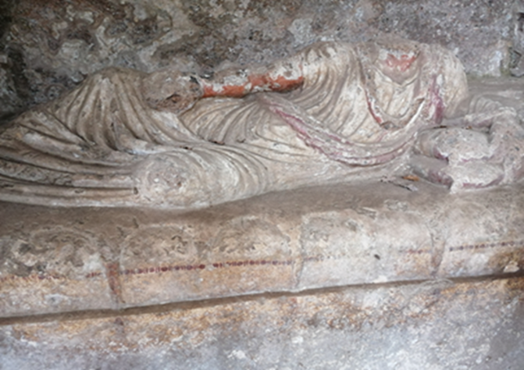 | Figure 2. “Winged Demons” tomb |
2. Experimental Work
- The measurements of pigments (Figure 3) in the tombs of the Etruscans were conducted using the Spectroscopic technique pXRF. Spectroscopic techniques are used in order to answer various questions concerning the structure, the pigments identification [6], and the qualitative and quantitative analysis of the elements of various compounds. The spectroscopy of the pigments was carried out on the spot on the murals and the statue, in the tombs of the Etruscans without the need for sampling and transport to the laboratory. The instrument used for the measurements was the Thermo Fisher Scientific portable XRF Niton XL5 spectrometer.It can detect the range of elements from Magnesium (Z=12) to Uranium (Z=92). The type of X-ray tube is Ag anode (6-50 kV, 0-500uA, 5W max), the current can be adjusted according to the sensitivity in each resolution.The usual size of focus is 8 mm and optionally the size is 3mm. The instrument withstands operation at a temperature of 0°C -50°C and humidity from 10% -90%. The software which was used to process the spectra is the Spectragryph [7].In total, 18 measurements were conducted in both tombs with the portable XRF spectrometer. The colours which were studied are: red, dark red, black, white, yellow and orange (Fig. 3).
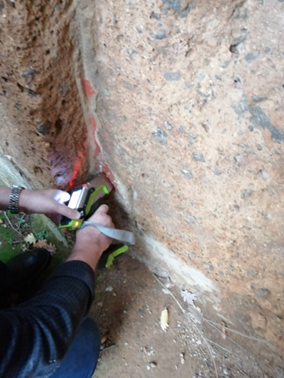 | Figure 3. In situ measurements using pXRF spectrometer |
3. XRF Characterization
3.1. Red
- The red colour measurements on the “Hildebrand” tomb (Figure 5) showed that it consists of the elements Ca, Fe, the trace elements: K, Sr, S. Mn, As, Ti and is attributed to the red ochre (Fe2O3). In the tomb of the “Winged Demons” the red colour consists of the elements Fe, Ca and the trace elements S, K, Ti, Mn, Sr where the red ochre (Fe2O3) is identified. The dark red in the tomb of the “Winged Demons” has Ca, Fe as main elements and it has S, K, Ti, Sr, Mn as trace elements corresponding to the red ochre (Fe2O3) and carbon black (C) pigments.
3.2. Orange
- The measurements of the orange colour in the tomb of the “Winged Demons” (Figure 4) showed the elements Ca, Fe and the trace elements K, S, Ti, Mn, Sr and from this it is concluded that the orange colour consists of the red ochre (Fe2O3) and the calcite (CaCO3).
3.3. White
- Calcite (CaCO3) was detected in the “Hildebrand” tomb from the element Ca and trace elements S, Fe, Sr, Mn. Also, in the “Winged Demons” tomb was identified calcite (CaCO3) from the element Ca and the trace elements S, K, Fe, Ti, Mn, Sr.
3.4. Yellow
- In the “Winged Demons” tomb the elements Ca, Fe and the trace elements As, K, Mn were identified and these indicate the yellow ochre (Fe2O3.nH2O).
3.5. Black
- In the “Winged Demons” tomb, black was identified as carbon black (C) from the elements Ca, Fe, K and the trace elements S, Ti, Zn, Mn, Sr.
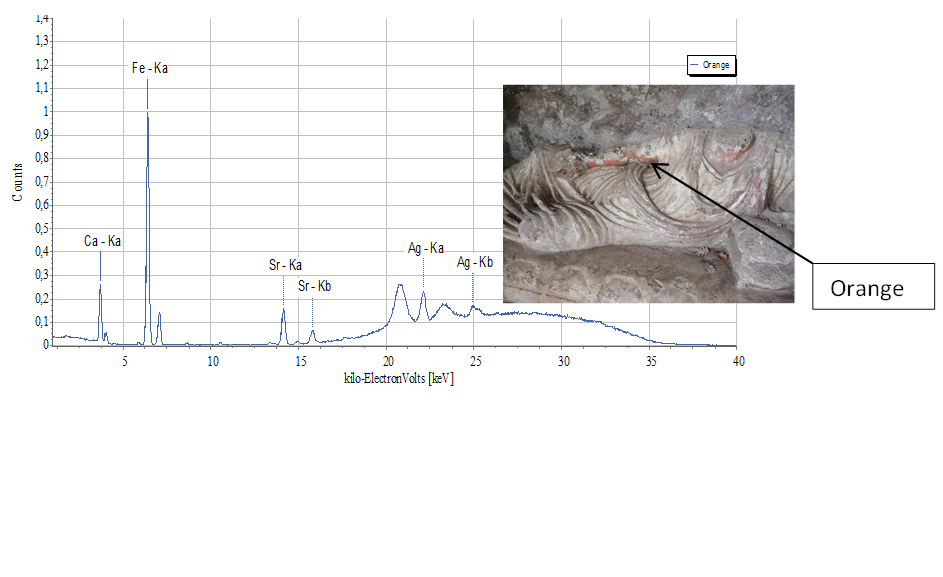 | Figure 4. XRF spectra of Orange |
|
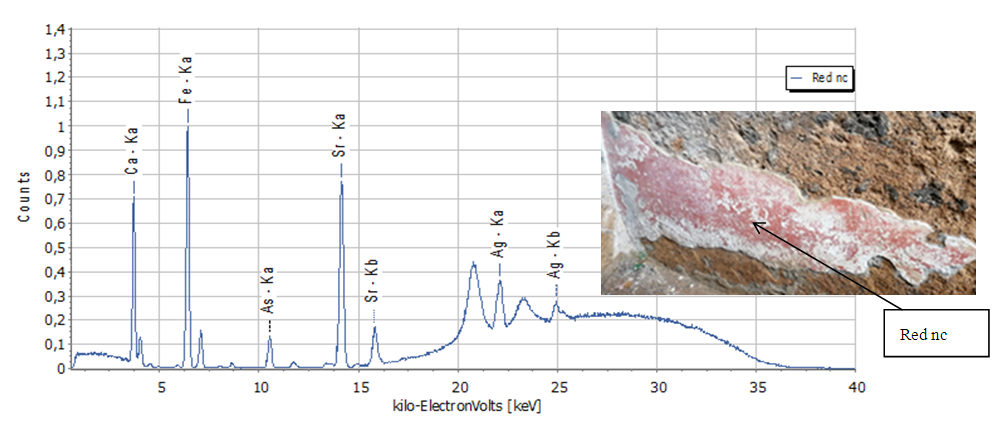 | Figure 5. XRF Spectra of red colour |
|
4. Conclusions and Discussion
- The results of this research indicated that: red consists of red ochre, black is made of carbon black, yellow is made of yellow ochre and white is made of calcite. In addition, dark red consists of red ochre and carbon black, and orange is made up of red ochre and calcite.Traces of the elements As, Mn, Ti, Zn, in yellow and red pigments may indicate impurities in the ores and in principle [8]. Mn, Fe, Sr, in white pigments are related to the composition of the painting substrate [3].The results of XRF pigment measurements in the Etruscan tombs in Sorano, Italy, are consistent with the results of other studies in relation to the detection of pigments for other Etruscan tombs. Especially, Bordignon (2007) analyzed the pigments from Necropolis in Cerveteri and found red ochre, yellow ochre, carbon black [2]. Also, Sodo (2008) studied the pigments in the Tomb “Dell ‘Orco” in the necropolis of Tarquinia and found red ochre, yellow ochre, calcite, and carbon black [3]. Last but not least, Pallecchi (2009) identified the pigments from the “Tomba della Quadriga Infernale” and found red ochre, yellow ochre and calcite [9].
ACKNOWLEDGEMENTS
- We would like to acknowledge the town hall of Sovana for providing help with conducting the measurements.
 Abstract
Abstract Reference
Reference Full-Text PDF
Full-Text PDF Full-text HTML
Full-text HTML